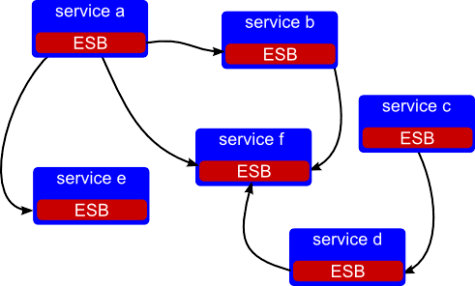Why you don't need an Enterprise Service Bus (ESB)
ESBs irk me, not the technology in and of itself, that can be useful, it’s the way they used. Mostly because every architect and his mentor seems to think you can’t have an architecture without one. I swear sometimes they must have the ESB icon pre-painted on their whiteboards because, splat, there it is, a hulking great rectangle in the middle of every systems diagram. They aren’t always called ESB, sometimes they sneak through as ‘Orchestration’ or ‘Integration Hub’ or a vendor product name.
I first came across the term ESB about 10 years ago, a colleague mentioned them to me and we discussed the concept over lunch, by the end of the lunch break we’d come to the conclusion they weren’t necessary or indeed desirable in an SOA. I’ll put forward some of the classic reasons architects give for using ESB and explain a better way to achieve each desired outcome or in some cases why that outcome isn’t desirable.
Before I go on I should explain the difference between the central ESB (bad) and using ESB technology in a more appropriate manner.

Figure 1. shows an ESB through which all services communicate, they are essentially unaware of each other and may be in the dark over what each others’ interfaces are. Now in the worst case the central ESB grows a team to support it. This is, after all, the obvious things to do, every service in the organisation wants changes all the time to what they use/expose from/to each other and therefore in order to prevent everyone hacking away at the ESB and general chaos the ESB team is created. All requests for change to the ESB go to the ESB team.
The ESB team are now furiously busy and considered heros for helping everyone communicate and are the first port of call from each service team to get what they need from the rest of the organisation. Soon they are getting requests for new functionality, however they don’t know how to change the services and perhaps it’s a little tricky to work out which service should handle that functionality so they slip a little bit of business logic into the ESB and call it orchestration, after all orchestration is what ESBs are for. This continues for a number of years until it dawns on everyone that the ESB contains most, or at least significant portions of the business logic and the services have become no more than CRUD layers over databases.

Figure 2. is ESB technology used in a more appropriate way, of course it is no longer a true ESB, because it isn’t “Enterprise”, it isn’t just one service bus for the entire enterprise. Each service uses ESB technology within itself to ensure their interface can be stable, they can use it to maintain multiple versions of the interfaces simultaneously but that is within the service. The service team has complete autonomy over what happens with their service now. In many cases they don’t need expensive software to do this, they can simply code it in the programming language of choice or use a simple library to achieve things like mediation, routing, location, security etc. Once each service has this capability the requirement for a central ESB team falls away entirely. As the organisation has been sensible and assigned teams for each service then those team speak to each other directly to get new functionality. The act of the teams talking directly to each other, face to face, person to person about their requirements also improves overall understanding of the organisations software assets.
Below I address some of the common reasons people give for using central ESBs and suggest more appropriate patterns for achieving the desired outcome.
The ESB Protects Me From Change
The argument here is that if you want Service A to call Service B you’d better go through the ESB in case Service B’s interface changes.
What should happen is that Service B publishes an interface and guarantees it won’t change for a period of time (say 12 months), if changes are required another version of just the interface is created and the old version is mediated on to that new version.
That’s quite a bit to take on so I’ll give a simple example. A company builds a service with an operation that exposes the price of various commodities, it returns a MoneyValue response:
MoneyValue getPriceOfGold()
This works perfectly until functional requirement gets added to return the price of silver too. The architects, being smart, realise this is probably not the last metal they will be asked to add and so they create a method that’s more flexible and looks like
MoneyValue getPriceOfMetal(Metal metal)
However there are several consumers of the old getPriceOfGold method. In order to support these clients they leave the old service interface in place but redirect calls from getPriceOfGold to getPriceOfMetal(gold) within the service and everyone is happy. Eventually they will ask consumers of getPriceOfGold() upgrade to getPriceOfMetal(Metal metal).
Therefore you don’t need a central ESB to achieve this objective, you don’t need anything outside the service but a bit of mediation logic in your service.
Extra Level of Protection
Just to quickly address the oft retort to the above that a central ESB gives another layer of protection, yes it does, but it comes with all the draw backs of the central ESB: adding logic in the wrong places, functional enchancement bottleneck and so forth.
The ESB Allows Me To Orchestrate Services
Orchestration is either business logic, which belongs in the service, this is the point of services after all, they contain your logic and data, or if it is simply a case of moving a human through some process or other then that belongs in the UI code (e.g. register for a website and then add something to your basket).
The ESB Can Mediate My Data
Yes it can but see above section ‘The ESB Protects Me From Change’, the mediation can be achieve much more sensibly in your service.
The ESB Can Locate My Services
Each service should have a mechanism for locating any other service for the purposes of RPC calls. I prefer to use DNS in most cases (e.g. metal-exchange.example.com would resolve to the metal exchange service interface or API), DNS has huge power but can be used very simply too. Bonjour (aka Zeroconf) is a often cited as a solution too and it’s a good answer but it merely some extentions to DNS at the end of the day. Others suggest things like UDDI but I have never found the need myself.
The ESB Can Do My Routing
For services that subscribe to events from other service, the same process can be used for locating those topics/queues, DNS to find the broker and well named and documented topics/queues on those brokers. Most message brokers provide means of routing messages from location to location sensibly, if yours doesn’t, get another.
The ESB Can Monitor My Services
Your services should provide monitoring information over any number of technologies that can be monitored by any number of technologies. Examples of technologies that can enable your services to be monitored are syslog, JMX, SNMP, Windows Events and simple log files — one or more of these are available in just about every language. Examples of technologies that can monitor those technologies are Nagios, OpenNMS and any number of commerical systems. You don’t need an ESB to do this.
The ESB Provides Extra Security
No they don’t, they remove security by terminating it prematurely. They open you to either deliberate or mistaken man in the middle attacks.